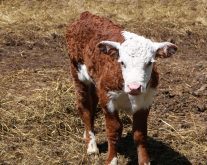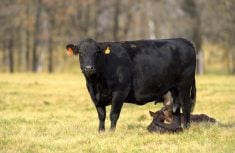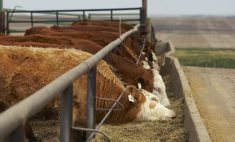No ifs or buts about it, producers who used meloxicam to ease the discomfort of branding, castration and other routine procedures on young calves in the past plan to use it again this spring.
Meloxicam is a non-steroidal anti-inflammatory drug (NSAID) to reduce inflammation, pain and fever, and fortunately Canadians now have three long-acting meloxicam products available for use in cattle. So far, none are registered in the U.S. for cattle.
Boehringer Ingelheim’s “Metacam 20 mg/ml Solution for Injection” (subcutaneous or intravenous) was approved in 2009 for calves over one week of age to improve appetite and weight gains at the onset of diarrhea, and for pain relief when removing horn buds in calves less than three months of age. In 2013, it was approved to treat inflammation and pain associated with acute mastitis and in 2016, for reducing pain associated with abdominal surgery, such as Caesarean sections in cattle.
Read Also

Canadian Beef Check-Off Agency reports on investments and activities
The check-off agency’s work behind the scenes is what ensures cattle check-off dollars are invested wisely, accounted for transparently and deliver measurable value back to producers and importers.
Meloxicam Oral Suspension by Solvet, a trademark of Alberta Veterinary Laboratories in Calgary, was licensed in late 2015 for the relief of pain and inflammation up to 56 hours after surgical and band castration of cattle. The medication is placed at the back of the tongue via a dosing syringe on the bottle.
Brand new from Merck Animal Health is Rheumocam Injection Meloxicam 20mg/ml (subcutaneous or intravenous) for pain when removing horn buds from calves less than three months of age and as an aid in improving appetite and weight gain when given at the onset of diarrhea in calves over a week of age.
For each claim, Jeff Estabrooks, the bovine/equine business unit director of Boehringer Ingelheim Canada, says the company must prove there is pain, how much meloxicam mitigates the pain, and for how long.
As a result, he says the introduction of Metacam to Canada in large part was due to mostly Canadian research that provided consistent ways to measure pain in cattle.
“There were the early adopters who saw the benefits right away and, absolutely, now we are seeing interest and uptake by beef and dairy producers increasing right across Canada,” he says. This mirrors a similar increase in the use of pain mitigation products for swine and sheep.
“I think the beef code of practice has had a huge impact and now producers are asking their vets about pain management instead of vice versa,” he says.
All the research and open discussion surrounding pain mitigation contributed to a much greater understanding of how beef cattle experience pain leading up to the release of the updated Code of Practice for the Care and Handling of Beef Cattle in 2013.
Alberta Veterinary Laboratories co-owner Dr. Merle Olson says feedback from veterinarians and producers has been overwhelmingly positive since the launch of Meloxicam Oral Suspension in the fall of 2015.
In addition to Rheumocam, Merck Animal Health has also released Banamine Transdermal (flunixin meglumine), a pour-on NSAID applied once a day along the topline for quick reduction of fever associated with bovine respiratory disease. Banamine Injectable (intravenous only for cattle) remains available as well.
There are other short-duration NSAIDs from the flunixin meglumine, aspirin and ketoprofen classes licensed in Canada for cattle. Your veterinarian will be able to suggest the most appropriate product for your intended use.
Producer experience
Mark Vermeulen, whose family has a commercial and purebred herd near Ceylon, Sask., used meloxicam for the first time at branding last spring on all castrated calves.
“When we went out to check a few hours after, we purposefully watched for a difference compared to other years. We saw that the calves seemed comfortable. They were moving around more and following the cows instead of lying around here and there,” he says.
He heard about meloxicam from producers who had used Metacam at branding the year before. His vet suggested the oral product and he liked the needle-free idea, in part because it would be a safe way for younger crew members to learn from experience. It was easy to give and he was satisfied that the calves received an effective dose because the product did what he expected it to do.
Ross Macdonald, 98 Ranch near Lake Alma, Sask., raises purebred and commercial cattle and has been using meloxicam in one form or the other for routine calf procedures since 2014. Going by the promotional material initially, it sounded like a product that could target the problem of those few calves feeling stressed, just standing in the corner of the branding pen swishing their tails at the end of the day.
“I’m happy because those 20-odd calves aren’t there any more. What I really like is the longer-term effectiveness. This has huge appeal for me because we brand right in peak grazing season and it’s nice to see those calves up and walking away,” he says.
Macdonald also uses meloxicam when branding yearlings and for any other procedure that is somewhat invasive or could cause discomfort.
“I conscientiously strive to be better and do better for the cattle and people working with the cattle. The reality is that castrating leaves us vulnerable to criticism just based on calf behaviour at the end of the day. With meloxicam, people see we’ve dealt with it.”
He sees the day not far off when use of pain medication will be a point of product differentiation for marketing. Already protocols for some branded beef programs ask for it and at least one he knows of has made it a requirement.
Chad Ross knew he had a good thing going with meloxicam after Solvet field rep Larry Frischke, demonstrated its use on a group of 150 calves at branding last year. The next day, some of the calves were playing on the hill just like any other normal day on the Ross L-7 ranch near Estevan, Sask. Encouraged by these results, they used oral meloxicam for the remaining 1,500 or so calves at branding.
“I liked it enough that we used it when we gave the boosters in October. We bring them home, vaccinate the cows and the calves, then turn the pairs back out on pastures. The vaccinations can make them feel feverish and shivery and it’s a stressful time to start with because of the move and the weather can be so changeable. I think I will continue with this as well,” he says.
On the feedlot side, all of the purchased calves received meloxicam with their vaccinations for the same reasons. The positive effect was very noticeable for calves that had to be dehorned and/or castrated because they were up eating at the bunk with the rest of the calves. They have since been using meloxicam along with the antibiotic prescribed in their protocols for treating health conditions in feedlot cattle.
“It’s a feel-good thing for us, too,” Ross says. “I think it will help with consumer perception if they see that we are doing the best we can for our livestock.”
Consumer perception was also on Daniel Doerksen’s mind when his family first tried meloxicam at branding in 2015 for all calves at Gemstone Cattle Co., near Gem, Alta.
“It helps us tell our story. We can say this is what we need to do and this is how we mitigate pain,” Doerksen explains.
True to what other producers had told him, the meloxicam products haven’t disappointed in the two years they’ve been using them. “The calves look like they are relaxed, not under duress, lying around, standing with humped backs or swishing their tails,” he says, adding that he is expanding use of meloxicam to procedures on older cattle and in conjunction with other treatments for health conditions such as footrot.
It seems to him that use of meloxicam at branding is becoming more commonplace in the region. Of the brandings he helped with in 2015, theirs was the only one where meloxicam was used, whereas it was used at about half the brandings he went to last year.
Loren Rodvang, near Coronation, Alta., noticed a similar trend in his area with a lot of neighbours using Metacam for the first time last year on word of positive results from producers or suggestion by the local vet.
He decided to put Metacam to the test in 2015 by giving it to all bull calves in their 500-head herd after hearing from his vet that people using it for procedures on young calves were noticing a difference for the better.
“This wasn’t a scientific study, but we are very sure we saw the calves lay around for less time and get back to work more quickly,” he says.
Glancing through the ranch’s health records he can confidently say that they have been using Metacam regularly since then, not only at spring processing but for heifers assisted at calving, and when calves get sick because it seems to make them feel better so they start eating and recover faster.
Near Lacadena, Sask., Tamara Carter says they initially used Metacam for cows and heifers after difficult calvings. Seeing it made them more comfortable, in 2013 she asked her vet if it could help reduce pain for calves at processing. One group of 30 calves had already been processed, so the bull calves in the second and third groups were the first to receive Metacam.
“We were surprised at how much faster they were paired up and nursing. It was a very noticeable difference from what we were used to seeing when they would spend a couple of days lying around. We were convinced right after that and used it for the steers in 2014 and 2015. Last spring, we included the heifers as well,” Carter says.
Problems with post-surgical scrotal infections because of lying around and with the occasional orphaned calf that would lie down in the bush and be left behind have disappeared since they’ve been using Metacam.
She believes that reducing discomfort and stress may help the calves’ immune systems stay stronger, improving overall health and potential weight gain.
“We noticed our weaning weights on the steer calves went up from 509 (in 2014), to 530 (in 2015) to 576 pounds last fall. Everything else has been the same — the same bulls and pastures, calving, turnout and weaning times every year. Could pain control be making the difference? We don’t have proof, but it is a solid observation.
“I see no negative or reason not to use it. It is good for the calves and the producer. It reassures our customers and the public that we are taking every step to acknowledge and manage pain,” she adds.
Sue Giles says they are thinking that the bump in weaning weights on their calves last fall could have been due to their use of pain medication at branding, although 2016 was the first year they had tried it.
Their vet at Brooks, Alta., suggested trying Meloxicam Oral Suspension for their first branding last spring because it was a group of 380 very young calves to be let out afterward into a 600-acre pasture. She was open to the idea, having used Metacam with great success treating cattle for pain from injuries and treating calves with scours.
“Amazing” is how Giles describes the response of young calves to oral meloxicam and they carried on using it for the rest of the calves, approximately 950 in all.
In past years, they would spend two days making sure the calves were mothering up. Last year, not one needed assistance and that time-saving alone was enough for her to say it definitely paid for itself.
Others helping at their brandings didn’t complain at all about the additional step and ended up using it at their own brandings because they knew about the positive results.
Kim and Jack Hextall near Grenfell, Sask., were a bit worried that their branding crew might think giving pain medication was just one more thing that would take extra time when Larry Frischke offered to demonstrate oral meloxicam at their branding last spring. They were pleasantly surprised when people called afterward to get their opinion on how it worked and if they’d use it again.
The answer is a double yes. Adding pain medication didn’t slow down the process. Afterward, the calves acted normal in every way with no signs of stress. They were mothered up and those lying down would stand and stretch as usual when approached the next day.
The Hextalls are on the same page when it comes to trying new technologies with potential to benefit animal husbandry because they have always seen animal care as being very important for their 300-head commercial and purebred herd.
Leighton Kolk takes a similar approach. He sees pain management as another step forward in doing a better job for animals and people at his family’s farm near Iron Springs, Alta., where they run a 20,000 head capacity feedlot operation, 275 mother cows plus field crops.
They have used local anesthetic for surgeries for 15 years and have made use of anti-inflammatory drugs to alleviate discomfort; however, those products require time and special training to administer.
When the easy-to-use meloxicam products came along, he was quick to bring them on board. For the past five years they have regularly used meloxicam for any painful process, bloat operations, difficult calvings, prolapse repairs, castrations and removing damaged horns.
Generally they see that cattle of all ages benefit from the use of meloxicam, but was particularly impressed at the results when castrating 600- to 800-pound calves. Previously it took five days for them to get back on feed, so they had to be grouped separately from the other calves for two weeks. With meloxicam, they might be somewhat uncomfortable for a time, but are up at the bunk and eating the same day. The meloxicam lasts about three days and the calves often return to their home pen a week earlier than before.
Douglas Lake Ranch cowboss Stan Jacobs says they thought of using Metacam at branding for several years before they first tried it. They had wondered if it would really make a difference, and if it was economically feasible for a herd this large. Today, the ranch runs 10,000 mother cows and 2,000 first-calf heifers at its Douglas Lake and Williams Lake locations.
“What really prompted us at the time was the Boehringer Ingelheim rep offered to help us find out,” he recalls. In 2014, they tested Metacam’s effectiveness on small groups of calves. The first 250 calves were vaccinated, branded, dehorned and castrated as usual. The second group received the same treatments plus Metacam and were marked with a dot on the back.
“The difference was remarkable,” says Jacobs. “Even coming out of the hold, the calves that received Metacam mothered up and over the hill and away they’d go. Since that day we have been using it for all of our calves. Anyone could see the results and they do justify the cost.”
The extra manpower needed was a very insignificant part of the cost. Their vaccination caddies now include four syringes instead of three and not much time needs to be spent refilling the Metacam syringe because the dose is small.
Kolk Farms and Douglas Lake Ranch were featured along with several researchers and veterinarians in the Beef Cattle Research Council’s video, What Producers Need to Know About Pain Control. It and the webinar recording, Practical and Effective Methods of Pain Control, and other resources on this topic can be found at www.beefresearch.ca/pain.

















